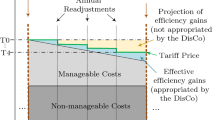Abstract
The electricity theft is an economic issue for the electricity company due to unbilled revenue of consumers who commit such action. In a regulated scenario, the company needs to fit within the laws of a regulatory agency (ANEEL in Brazil) and the loss of revenue is a problem that can compromise the compliance with regulatory targets and business efficiency. The objective of this article is to analyze how the energy theft impacts on the economy of the regulated company, consumers and society as a whole. Through the economic model TAROT (optimized tariff), it was possible through a concise and comprehensive manner to analyze the regulated electricity market using simulations and discover in which points the company operates regulated and through it to determine the economic indicators.












Similar content being viewed by others
References
Al-Mahroqi, Y., Metwally, I. A., Al-Hinai, A., & Al-Badi, A. (2012). Reduction of power losses in distribution systems. International Journal of Electrical, Computer, Energetic, Electronic and Communication Engineering, 6(3)
Amin, S., Schwartz, G. A., Cardenas, A. A., & Sastry, S. S. (2015). Game-theoretic models of electricity theft detection in smart utility networks: Providing new capabilities with advanced metering infrastructure. IEEE Control Systems, 35, 66–81.
Amin, S., Schwartz, G. A., & Tembine, H. (2012). Incentives and security in electricity distribution networks. In J. Grossklags & J. Walrand (Eds.), GameSec 2012, LNCS 7638 (pp. 264–280)
ANEEL. (2008). Second periodic tariff revision of electric power distribution company. Technical report 33/208., Technical report, Brasilia, Brazil (in portuguese).
Arango, H., Abreu, J. P. G., Bonatto, B. D., Kagan, N., Tahan, C. M. V., & Gouvea, M. R. (2008). A model for electricity markets: the impact of regulation on value. In 2008 5th international conference on the European electricity market, EEM
Arango, H., Abreu, J. P. G., Bonatto, B. D., Tahan, C. M. V., Kagan, N., & Gouvea, M. R. (2008). The economic impact of power quality and its optimal regulation. In Induscon-VIII international conference of industrial applications, Pocos de Caldas, Brazil (in Portuguese)
Arango, H., De Abreu, J. P. G., Bonatto, B. D., Tahan, C. M. V., Kagan, N., & Gouvea, M. R. (2010). The influence of quality on the creation of economic value in electricity markets. In ICHQP 2010—14th international conference on harmonics and quality of power
Arango, L. G., Deccache, E., Bonatto, B. D., Arango, H., Ribeiro, P. F., & Silveira, P. M. (2016). Impact of electricity theft on power quality. In IEEE PES ICHQP 2016-17th international conference on harmonics and quality of power, Belo Horizonte, Minas Gerais State, Brazil
Electricity North West Limited. (2015). Losses strategy. http://www.enwl.co.uk/docs/default-source/default-document-library/electricity-north-west---losses-strategy---april-2015.
Fourie, J. W. (2004). A strategy for the management of energy losses in a local electricity distribution network, Master thesis, Faculty of Engineering, the Built Environment and Information Technology-University Of Pretoria
Jehle, G. A., & Reny, J. P. (2000). Advanced microeconomic theory (2nd ed.). Boston: Addison Wesley Longman.
Martin, J. D., & Petty, J. W. (2000). Value based management. Boston: Harvard Business School Press.
Millard, R., & Emmerton, M. (2009). Non technical losses: How do other countries tackle the problem In AMEU convention
Penin, C. (2008). Combat, prevention and optimization of electrical energy commercial losses, Ph.D. thesis, Polythecnic School from the University of Sao Paulo (in Portuguese)
Smith, T. B. (2004). Electricity theft: A comparative analysis. Energy Policy, 32, 2067–2076.
UK Power Networks. (2014). Business Plan (2015–2023)-Annex 7: Losses strategy.
World bank group energy sector strategy. (2009). Reducing technical and non-technical losses in the power sector.
Acknowledgements
The authors would like to thank ELETROBRAS, ANEEL, INERGE, CAPES, CNPq and FAPEMIG for financially supporting this research.
Author information
Authors and Affiliations
Corresponding author
Appendix
Appendix
TAROT (acronym for optimized tariff) is a model based on demonstration of the company’s value. It combines the EVA calculation methodology, worldwide popularized by the company STERN and STEWART with ANEEL regulatory procedure for tariff revision. TAROT is based on a structure of expenditures (G), appropriate to electrical distribution system, which relates the costs in proportion to sales, technical losses and depreciation on investment. Starting from the revenue (R), results taxable gains (EBIT \(= R - G\)) and taxes (\(X = t\).EBIT). Finally, capital remuneration is subtracted (\(Y = r_{w}.B\)) where (B) is the investment and (\(r_{w}\)) the cost of capital (WACC—weighted average capital cost).
Rights and permissions
About this article
Cite this article
Arango, L.G., Deccache, E., Bonatto, B.D. et al. Study of Electricity Theft Impact on the Economy of a Regulated Electricity Company. J Control Autom Electr Syst 28, 567–575 (2017). https://doi.org/10.1007/s40313-017-0325-z
Received:
Revised:
Accepted:
Published:
Issue Date:
DOI: https://doi.org/10.1007/s40313-017-0325-z




